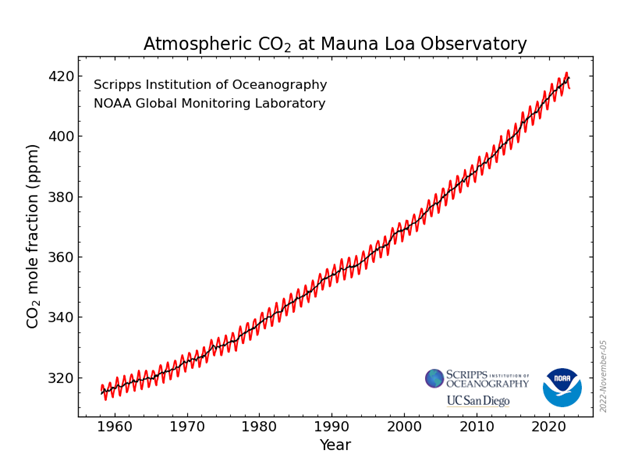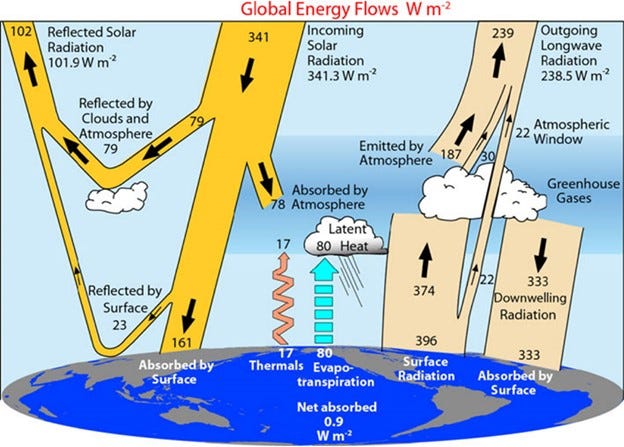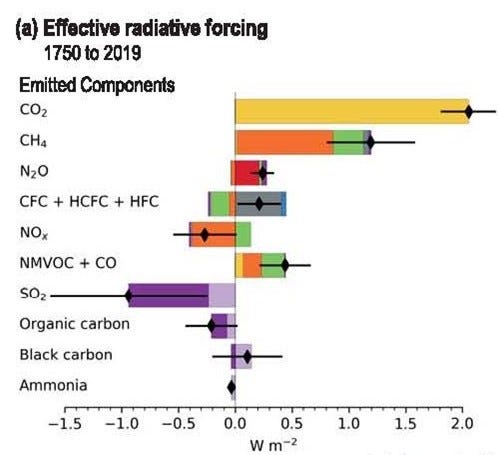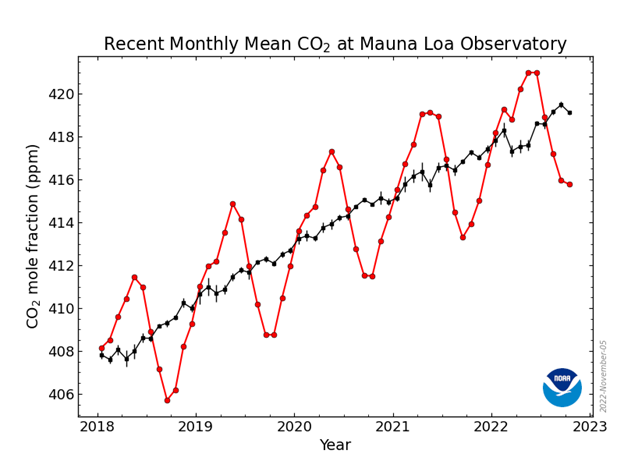How Carbon Dioxide Emissions Change the Climate
Roger Pielke Sr. joins The Honest Broker (SERIES: Pielke Sr., Part 1)
From the editor: I am really pleased to announce that my Dad, pictured above, has agreed to become a recurring contributor at The Honest Broker. For those who do not know him, he is among the most accomplished and influential atmospheric scientists of his generation. If you like weather forecasts, well, give him a shout, as his work since the 1970s has been fundamental to their development and improvement. Although he claims to be “retired,” Google Scholar shows that he has 11 publications so far in 2022, along with his ridiculous H-index of 101 (for those who count such things). His career is being celebrated at the 2023 annual meeting of the American Meteorological Society next month, where I will give the lunch talk roast, and it will be attended by many of his colleagues and former students. Here at The Honest Broker, Pielke Sr. will focus on core issues in the atmospheric and related sciences, ideally with a lot of input from readers. He welcomes engagement so please feel free to use the comments to ask questions and have a dialogue. This first post addresses a request that I get a lot here and elsewhere — can you explain in plain English how we know that carbon dioxide affects the climate? We are all lucky to have my dad participating here, enjoy! Thanks Dad! -RP2
How Carbon Dioxide Emissions Change the Climate:
A guest post by Roger Pielke Sr., part of a new SERIES here at The Honest Broker

Carbon dioxide (CO2) is a gas in the atmosphere, a part of a “carbon cycle” involving the exchange of carbon in various forms between the atmosphere, land and oceans. The carbon cycle involves biological processes such as vegetation growth, respiration, photosynthesis, and decomposition, as well as geological processes such as volcanism. The oceans and rocks store vast amounts of carbon.
Oil, coal and natural gas (fossil fuels) extraction accesses stores of carbon millions of years old. Today, the burning of fossil fuels is releasing large quantities of this ancient carbon into the atmosphere as carbon dioxide. The resulting increase in carbon dioxide in the atmosphere— which you can see in the graph at the top of this post — has major effects on the climate system.
This post explains the primary influences of increasing atmospheric carbon dioxide on the climate system resulting in changes to the Earth’s climate. Carbon dioxide makes up only about 0.04% of air but even so, it has major effects on the Earth’s climate. Because carbon dioxide stays in the atmosphere for a very long time (technically, called its residence time) added carbon dioxide has long-lasting effects on climate.
Increasing amounts of carbon dioxide in the atmosphere has two primary effects -- an effect on the heat in the climate system and on the Earth’s biology. Technical terms used to define these two effects are the radiative effect and the biogeochemical effect. I’ll discuss each in turn.
The Radiative Effect of Added Carbon Dioxide
Without carbon dioxide in the atmosphere, the Earth’s climate would be much colder. The Earth’s temperature involves a balance between heat energy received from the Sun and the heat from the Earth radiated back into space.
Go outside on a sunny day and you can feel the heat from the Sun. This heat is transmitted from the Sun to the Earth mostly in visible wavelengths of light, those that we can see. This heat can be broken into two parts — a small fraction which is absorbed by the Earth’s atmosphere and a much larger fraction that is absorbed by the Earth’s surface. Touch a dark surface during the middle of the day, for example, and it can be quite warm even hot, and can easily reach a higher temperature than the surrounding air. This is heat that has been absorbed into the surface.
Some of this heat is also reflected back into space. The fraction of the reflected heat is called the albedo, with larger albedo values indicating greater reflection. Surfaces such as snow, for example, have a higher albedo than a spruce forest which will in turn have a higher albedo than an asphalt parking lot.
Some heat absorbed by the Earth’s surface that enters the land surface and oceans is emitted back (upwards) into the atmosphere (at longer electromagnetic wavelengths). Referred to as upwelling long wave radiation, the wavelengths are predominantly in the infrared, which we cannot see.
Unlike downwelling solar radiation from the Sun, which passes through the atmosphere with little impact on the temperature of the air (and a significant reflection within the atmosphere back into space only from clouds), upwelling long wave radiation is absorbed by certain air molecules. The air molecules that intercept long wave radiation before it escapes into space include carbon dioxide and water vapor (plus others, such as methane). This absorbed energy is then reemitted back downward, adding to the overall heat content of the Earth system.
Some of the heat from the Earth surface also is transferred upward by turbulence as sensible heat (heat that we can measure with a thermometer) and latent heat (which is in the form of water vapor). Heat is also transferred into the ground (primarily by conduction) or into the oceans (solar energy can typically reach hundreds of meters down into the ocean where it warms the water; and heat in the ocean is transferred further downward by turbulence). Heat transfers within the Earth system are both fascinating and complex.
Global warming of the surface and atmosphere by the interplay of the fluxes of energy is illustrated in the figure below. The role of CO2 is in its absorption of upwelling long wave radiative heat fluxes from the Earth’s surface and within the atmosphere, and its reemission back downward.

The resulting warming has been called the “greenhouse effect.” It’s a misnomer, of course, as real physical greenhouses heat up because the glass roof admits downward solar radiation, but the glass roof minimizes the turbulent sensible heat movement upward of the warmed air. Nonetheless, that is the term we use. This atmospheric greenhouse effect results in an Earth that is significantly warmer than it otherwise would be. Without this greenhouse effect, there would be no downwelling heat.
Since industrialization, fossil fuel emissions, agriculture and other activities have added to the naturally occurring carbon dioxide of the atmosphere. This added carbon dioxide increases downwelling radiation, and, as a result warms the troposphere (the lower atmosphere) and the surface. The latest IPCC report presents their estimate of the change of effective radiative forcing due to carbon dioxide from 1750, shown in the figure below. The magnitude of this added downwelling radiation is significant.

Adding carbon dioxide to the atmosphere thus allows more upwelling long wave radiation to be captured before it can escape to space, and this energy is re-radiated back towards the Earth’s surface, thus resulting in a warming of the Earth system. The result is global warming due to the radiative effect of carbon dioxide.
There is no ambiguity that the increase of atmospheric carbon dioxide from human activity heats the Earth system by increasing downwelling radiation in the atmosphere. It results in warmer surface temperatures, troposphere and oceans from what they otherwise would be.
The Biogeochemical Effect of Added Carbon Dioxide
Increasing carbon dioxide in the atmosphere also influences the climate system due to its important role in the biological, physical and chemical dynamics of soil and vegetation. This biogeochemical effect involves photosynthesis and plant growth (among other biological influences). The biogeochemical effect of carbon dioxide on climate forcing remains less well understood than the radiative effect.
Seeking to improve our understandings of the biogeochemical effects of carbon dioxide on the climate systems has been one focus of my research over many decades. I have often called for leading scientific assessments to pay more attention to these issues, and I am pleased to see them moving in that direction – though there is still more to do.
The biogeochemical effect of plant growth can be readily seen in the analysis of the atmospheric concentrations of carbon dioxide. Shown in the figure below is the long term upward trend in concentrations of atmospheric carbon dioxide, and in the annual wiggles up and down (in red) you can see its annual cycle as plants uptake carbon dioxide into their leaves and foliage (mainly in the northern hemisphere spring and summer where most plants are) and then transfer carbon dioxide back into the atmosphere from decomposition and respiration in the autumn.

Carbon dioxide, of course, is essential for plant growth and when it increases in the atmosphere it provides an enriched atmosphere for photosynthesis and thus vegetation growth. On the global scale, satellite observations show a clear response of vegetation greenness to increased atmospheric carbon dioxide concentrations. For instance, recent studies by Zhu et al. and Piao et al. conclude that a quarter to half of Earth’s vegetated lands have shown significant greening over 35 years, largely due to rising atmospheric carbon dioxide levels.

Enhanced plant growth also directly affects the global average radiative forcing of the climate system. It does this by changing surface albedo (the fraction of solar radiation that is reflected from the surface), but also by directly altering the amounts of heat and water vapor in the atmosphere. Such fluxes – as they are called – alter patterns of clouds and precipitation from what they otherwise would be in the absence of the vegetation changes.
Things get more complicated when looking at the biogeochemical effects of added carbon dioxide on regional climates. Changing vegetation patterns results in local and regional changes in radiative heating. The changes in heating result in variously warmer and cooler regions in the atmosphere, which then produce gradients in horizontal pressure fields – differences in regions of atmospheric pressure – which are responsible for driving wind fields, resulting in what we call weather.
These spatial gradients in atmospheric pressure affect the development and evolution of atmospheric circulations such as El Niño and La Niña, North Atlantic Oscillation, Pacific Decadal Oscillation and so forth. Such circulations play a major role in societally and environmentally important weather events such as droughts, tropical cyclones and floods.
To sum: The radiative effect of added carbon dioxide to the atmosphere is a first order climate forcing and its influence on global warming has been robustly demonstrated. The biogeochemical effect of added carbon dioxide is also a first order climate forcing and results in significant changes to regional climate, although quantifying them is more complicated. The biogeochemical effect and the radiative effect interact as well.
Carbon dioxide emissions from the burning of fossil fuels, and other alterations to the carbon cycle, result in a warming of the planet from what would have occurred otherwise. They also contribute to changes in vegetation and soil dynamics, with resulting substantial effects on climate and weather.
For further reading:
Pielke Sr., R.A., D. Peters, and D. Niyogi, 2022. Ecology and climate of the Earth: The same biogeophysical system. Climate. (PDF)
Pielke Sr, R. A. 2013. Mesoscale meteorological modeling. Academic press.





I'm glad to see Sr. join the Honest Broker. Good straightforward write up on carbon dioxide in the atmosphere, although I've never seen the terms upwelling and downwelling used in the context of atmospheric radiation but then again my training in MetOcean goes back to the '60s.
Ultimately though the questions remain:
1. Is climate change an existential issue?
2. Will climate change have catastrophic effects?
3. Is there any reason we must achieve "Net Zero" by 2030 or 2050?
4. Given what we know, are the effects of climate change likely to fall within the envelope of adaptability.
Good morning from the UK.
It's great to read an article which doesn't try to implicate "Goodies or Baddies"!
I am firmly against climate alarmism, although I cannot disagree with anything written here by Roger Sr.
The issue that the wider subject faces is the politicisation of scientific reports or papers that arises when interested parties try to force their chosen narrative for political or ideological reasons.
Keep up the unbiased and non-partisan work. We desperately need steady hands on the tiller right now.